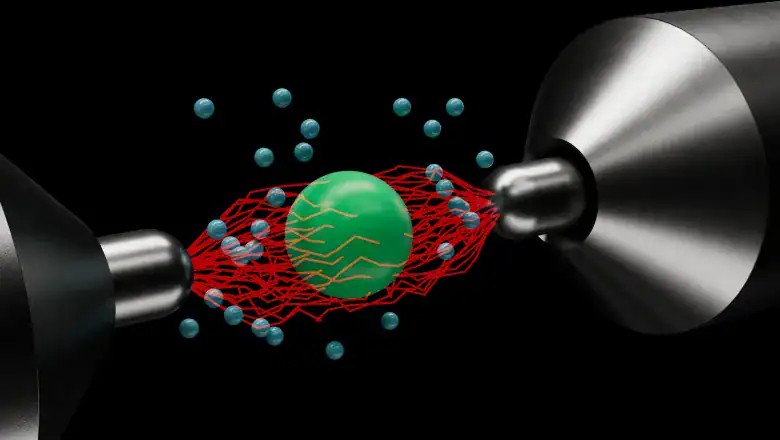Scientists have built the world’s smallest engine. It consists of a single microscopic particle, smaller than a human cell, levitating in a vacuum. By rattling this lone particle with “noisy” electrical fields, a team from King’s College London (KCL) and their collaborators heated it to an astonishing 10 million Celsius, or about 18 million degrees Fahrenheit. That’s millions of degrees hotter than the sun’s surface and over three times hotter than the sun’s blazing outer atmosphere, the corona.
But the heat, while record-breaking, is just the headline. The real discovery lies in the bizarre physics happening at this scale.
Hot and Random
In classical physics, an engine is any mechanism that converts one form of energy to another. For instance, add heat and you get work. Simple, elegant, and you always follow the rules of thermodynamics. But at smaller scale, things get weird.
To build this engine, the researchers used a device called a quadrupole ion trap, or more simply, a Paul Trap. This machine uses oscillating electrical fields to trap a single, charged microparticle, levitating it in a near-vacuum. This setup isolates the particle from its surroundings. Then, the team applied a noisy, random voltage to the trap’s electrodes. This “noise” violently jiggled the particle, causing it to move and generate a lot of heat.
But unlike a steam engine, its behavior wasn’t predictable. For any given engine run, the particle’s behavior was sometimes “stochastic,” or random. When exposed to a heat source, the particle would sometimes cool down instead of heating up, a direct contradiction of what we expect.
If you’ve paid attention during physics classes, you may think this is a violation of the laws of thermodynamics; in principle, you’d be right.
At very small scales, the laws of thermodynamics don’t work as we’re used to. In this emerging field called stochastic thermodynamics, the laws of thermodynamics are respected on average, but sometimes, you get really weird, counterintuitive behavior. An atom would follow statistic laws on average, but on any given run, there is no average. It is all fluctuation.
Molly Message, a PhD student at the Department of Physics at King’s College London and first author of the paper, explains:
“Engines and the types of energy transfer that occur within them are a microcosm of the wider universe. Studying the steam engine brought about the field thermodynamics, which in turn revealed some of the fundamental laws of physics. The continued study of engines into new regimes offers the potential to expand our understanding of the universe and the processes that drive its development.”
“By getting to grips with thermodynamics at this unintuitive level, we can design better engines in the future and experiments which challenge our understanding of nature.”
Curiously, this research ties in with the idea of folding proteins.
An Engine to Understand Proteins
This small scale seems widely decoupled from reality. But life itself sometimes operates at this scale. Bacteria, viruses, and the molecular machines inside our own cells are all single-particle engines. They don’t run on predictable averages; they live among thermal noise.
But this is even more exciting from a practical perspective as this bizarre particle engine can be an “analogue computer” to model protein folding.
Proteins are the engines of life. They are long chains of amino acids that must fold themselves into precise, complex 3D shapes to function. When they “misfold,” they can clump together, leading to devastating diseases like Alzheimer’s, Parkinson’s, and cystic fibrosis. The challenge is that predicting how a protein folds is one of the hardest problems in science.
In the past few years, Google’s DeepMind made historic breakthroughs with AlphaFold, an AI that could accurately predict the final 3D shape of a protein from its amino acid sequence. This even won the Nobel Prize in Chemistry.
But AlphaFold has a crucial limitation. It shows you the starting point (the chain) and the end point (the final shape), but it doesn’t show the path it took to get there. It doesn’t model the actual process of folding. This is key to understanding misfolding, where the protein takes a wrong turn on its path.
Digital supercomputers struggle to simulate protein folding because they must calculate billions of nanosecond-scale atomic movements, requiring astronomical computing power.
The KCL engine solves this by acting as an “analogue computer.” Instead of calculating the problem digitally, it physically simulates it. A levitating particle represents the protein, while tuned electrical fields and “noisy” voltage mimic the random thermal forces a real protein experiences inside a cell, allowing researchers to directly observe the folding process.
“The advantage of our method over conventional digital models like AlphaFold is ease. Proteins fold over milliseconds, but the atoms which make them, move over nanoseconds. These divergent timescales make it very difficult for a computer to model them. By just observing how the microparticle moves and working out a series of equations based on that, we avoid this problem entirely.”
Like the steam engines that sparked the Industrial Revolution and modern physics, this microscopic engine might push us into the next frontier — one where chaos isn’t a bug in the system, but the system itself.
The study was published in Physical Review Letters.

